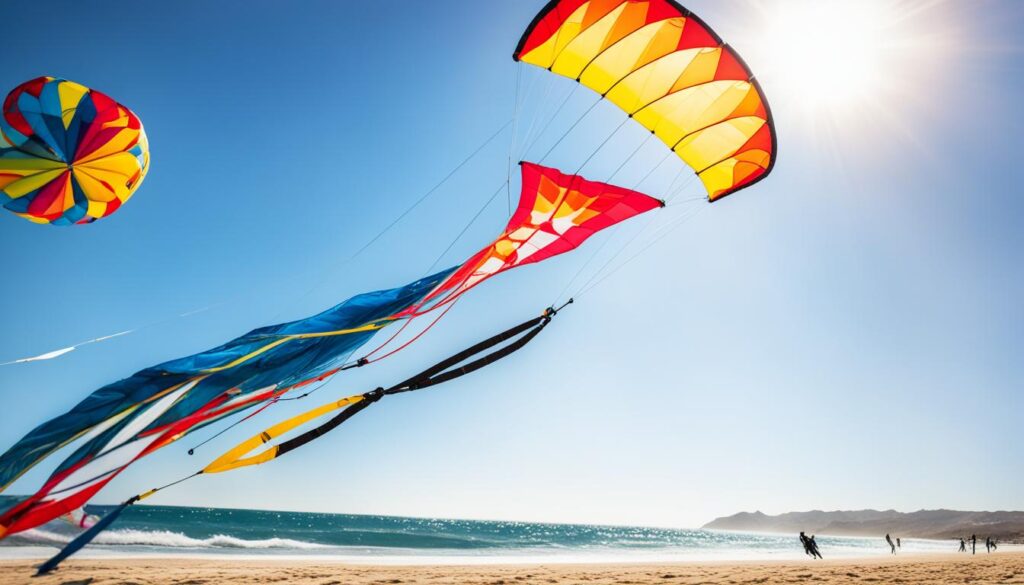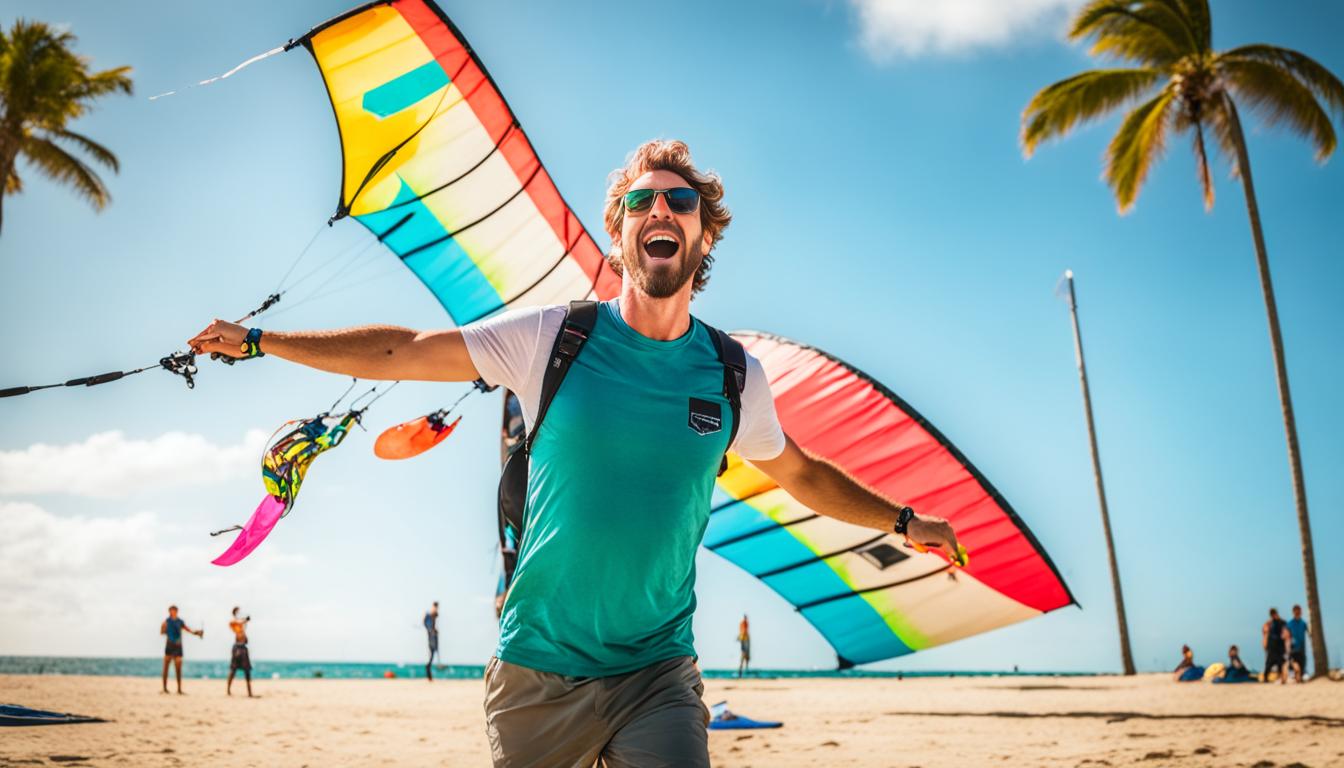Welcome to the world of kitesurfing, where wind and waves meet for fun! If you like the idea of surfing with a kite, you’re in the right spot. This guide will teach you the basics of kitesurfing. It will help you go from watching to doing.
Learning the basics is key before you start kitesurfing. It makes it safer for you and others. This guide is your first step into the exciting world of kitesurfing.
We will cover everything you need to know about kitesurfing. From learning about the gear to doing your first moves on the water. Let’s start and learn how to use the wind’s power!
Understanding the Basics of Kitesurfing
Kitesurfing mixes surfing and paragliding for a fun ride. Before diving deep, beginners need to know the basics. This part covers the key stuff like gear, weather, and kitesurfing styles.
Knowing when it’s windy enough is key. Too little wind is bad, too much is worse. You’ll also need the right gear like a kite, board, harness, and safety stuff. Each style, like freestyle or speed kitesurfing, needs its own gear.
The sound of sails and the ocean shows how kitesurfing works. Learning to control the kite in the wind is crucial. It helps you speed up or slow down in the water. This skill opens the door to more fun moves.
There are many ways to kitesurf, each with its own style. Freestyle is all about cool tricks in the air. Wave riding is like surfing but with a kite. Speed kitesurfing is all about going fast on the water. Each style needs its own skills and gear.
Learning these basics helps beginners get better and stay safe. It makes starting out in kitesurfing fun and exciting.
Step 1: Getting Familiar with Your Gear
Starting your kitesurfing journey means learning about your gear. You’ll need to know about your kite, harness, board, and safety gear. Each item is key to a safe and fun time on the water.
Choosing the right gear is important. It should fit your skill level and body type. A good harness and kite size make a big difference in how you handle and feel the board. Talk to experienced kitesurfers or trusted sellers for advice on beginner gear.
Setting up your gear is a big step. Begin by laying out your kite on a flat, clear area, away from things that could harm it. Then, attach the lines as the maker says, making sure everything is tight. This step builds your confidence and safety as you get ready for the waves.
Don’t forget about gear maintenance. Check your safety releases and kite lines often for damage. Cleaning and drying your gear after each use protects it from saltwater and sun damage.

Learning about your kitesurfing gear is ongoing. Practice setting it up and understand how it works. This will help keep you safe and improve your kitesurfing skills.
Step 2: Learning Basic Kite Control
Learning to control a kite is key before you start kitesurfing. It helps you learn faster and stay safe. You need to know how to move the kite in the wind window, an area in the sky where it can fly well.
Launching and landing a kite might seem easy, but it’s not. You need to control it well and know the wind. Start on land with a certified teacher to get good at it. Practice in different winds to see how the kite moves.
When you’re more comfortable, work on handling sudden gusts or wind changes. These tests your quick thinking and kite skills. Practicing will make you better at controlling the kite and ready for water kitesurfing.
It’s best to take lessons from a pro for beginners. They give you structured learning and feedback. With expert help, you’ll get the hang of wind windows and power zones faster. This makes kite flying easier and prepares you for water kitesurfing.
Step 3: Mastering Water Starts and Basic Maneuvers
Starting with water start kitesurfing is super exciting for beginners. It’s the first step to learning more advanced moves. It helps you control the kite while on the board. You’ll feel the thrill of flying off the water with practice.
To start, make sure your body is in the right position. The board should be straight to the kite’s pull. When the kite lifts, lean back a bit and bend your knees. This is key to flying the kite and riding the waves.

After getting the hang of water starts, try simple moves. Use smooth moves to turn and steer the kite. Start with small turns to see how you move on the water. Keep your balance and control your speed for a smooth ride.
Master these basics for a strong start in kitesurfing. Practice in safe places to get better. With each try, you’ll get better at this exciting sport.
Step 4: Improving Your Kitesurfing Skills
As you get better at handling your kite on the water, it’s time to take your skills to the next level. You’ve learned the basics or had a few rides. Now, learning expert kitesurfing tips can make you better and more fun.
To improve, work on your technique first. It’s key to know how to handle different winds. Every time you go out, you’ll face new challenges. Learning to adjust your plan is important for getting better.
Being in a kitesurfing group is great too. It helps you stay motivated and learn from others. You’ll get to share tips and techniques with others, which helps you grow.
Also, keep a journal of your kitesurfing. Write down the wind, how you did, and how you felt. This helps you see what you need to work on. Setting goals for each session or season keeps you motivated.
Lastly, practice every time you can. Each session is a chance to try new things and improve. Always be open to learning from your experiences. Every wave and ride helps you get better.
With these tips, your kitesurfing journey will keep being exciting and rewarding. Keep practicing, join the community, and remember, getting better at kiteboarding is about hard work, adapting, and having fun.
Staying Safe While Kitesurfing
Kitesurfing is exciting but also requires safety to have fun without getting hurt. It’s key to follow kitesurfing safety tips, especially if you’re new. Know your gear and the place you’re in before you start.
Always check your kite before you go out. Look for any tears and make sure lines aren’t tangled or worn. Your harness should fit well and be secure. Then, learn about the area you’ll be in. Weather, water, and wind are important for safe kitesurfing practice.
It’s also important to know how to use your safety release systems. These let you get free from your kite fast if needed. Learning how to use them can save your life.
Knowing the rules of the water and how to rescue yourself is key. Stick to what you’re good at to avoid accidents. Always kite with a friend and tell them where you’re going and when you’ll be back.
By following these kiteboarding precautions, you protect yourself and others. With safety steps in place, kitesurfing can be exciting and worry-free.
Conclusion
Your kitesurfing journey is just starting. You’ve learned the basics and how to start on the water. Kitesurfing is exciting, full of challenges and wins. Remember, success comes from being patient, practicing, and never giving up.
Being part of the kitesurfing lifestyle means more than just improving your skills. It means joining a fun community and enjoying the freedom of kitesurfing. With every wind and wave, you’ll feel part of a world full of adventure and friends.
As you get better, think about what’s next. Look for new places to kitesurf, join events, and learn more to improve your skills and stay safe.
The world of kitesurfing is big and full of possibilities. Keep being curious and loving this sport. Respect the nature that makes kitesurfing special. Your kitesurfing journey is about enjoying life’s amazing moments with the wind and waves.
